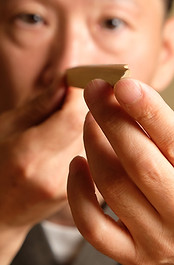



古くから日本の伝統技法として伝わる「截金(きりかね)」
截金は、極細に切った金箔や銀箔、プラチナ箔を糊で貼り、文様を描く特殊技法。日本では飛鳥・奈良時代から鎌倉時代に隆盛を極め、仏像や仏画や装身具を荘厳に彩るために発展し、彩ってきました。古くは飛鳥・奈良時代から始まり日本の仏教美術・芸術には欠かせない技法ですが、時代を経てその美しさは美術工芸としても高く評価されるように。現在は、日本伝統の美術・工芸の分野でもその技が継承され、京都市の伝統産業として認定されています。
とはいえ、時代の変化とともに、日常で身近にその截金に触れる機会も大変少なくなり「截金」という言葉を知らない人が多い状況に。また截金という言葉を聞いたことがったとしてもその希少性やその素晴らしい価値を知らない方も多く、その状況に伴い、截金を施すことができる専門の截金師の人数も減少し、仏像や仏画に携わることができる一流の截金師は希少な存在になっています。そして、身近に触れる機会が減少し「截金」
自体を知らない人も増加。截金の芸術的な技術を継承していくことも課題の一つに。
そのような中で、截金師清水とデザイナー重住が共に共感した、繊細にして荘厳な金箔・銀箔の繊細なラインから描かれる「截金」の神秘的な世界に魅せられ、発想したことで日本の文化とその芸術性を感じる繊細で優美なジュエリーブラン「K.KIRIKANE」は誕生しました。
さりげない日常の中でも、特別な日を彩るジュエリーとしても、仏像を荘厳に彩ってきた歴史と日本の美しい伝統技術、その素晴らしさを身近に感じながらそれぞれの大切な輝く時間を過ごしていただけたら。そのような思いを込めK.KIRIKANEのジュエリーをお届けしています。
《About Kirikane》 Kirikane (literally, cutting metal foil) is a traditional Japanese technique that employs gold or silver foil cut into very fine strips, which are laid on a surface with glue to form decorative patterns. In Japan, the kirikane technique flourished from the Nara to Kamakura periods (from the early 7th century to the mid-14th century), and was used mostly for decorating Buddhist statues and paintings. While the technique has remained vital for Buddhist art since early times, over the centuries the beauty of kirikane works has become highly appreciated as an artistic handicraft. Today, this exquisite technique is also being continued in the field of Japan’s traditional arts and crafts.



Filled with Mysterious Colors, Grain Patterns, and the Warmth of Wood
「K.KIRIKANE」のもう一つの魅力は「木」。
太陽と大地のエネルギーを受けて育った木には、生命力と神秘の力が宿ります。樹種が異なれば色も質感も違う。同じ木材でも、使う部位や切る方向によって木目の表情が変わる。
自然の美しさを活かしながらデザインされた唯一無二のジュエリーはつける人にぬくもり、安らぎ、そして雄大な力を感じさせてくれます。
K.KIRIKANE's other charm is the power of wood. Wood that has absorbed energy from the Sun and the Earth is full of vitality and mystery. Different types of wood provide different colors and textures. Even a single piece of wood brings out a variety of expressions in the grain according to the portion used or the direction in which it is cut. When you wear this one-of-a-kind jewelry designed by taking advantage of the beauty of nature, you will feel its warmth, comfort, and great power.
Adding Pleasure to Japanese Elegance
自然を愛し、伝統を守る……
そんな和の心に、軽やかで楽しい遊び心を加えたのが
「K.KIRIKANE」の世界です。
木のぬくもりと截金の繊細な美しさを、シンプルに、スタイリッシュに。つけるだけで心が弾むワクワク感を、あなたにお届けします。
Preserving nature, and respecting traditional culture… To these core concepts of the Japanese spirit, adding a sense of lightness and fun brings you to the world of K.KIRIKANE. Just by putting it on, you will feel a sense of excitement while appreciating the simple but stylish expression of the warmth of wood and the delicate beauty of kirikane.


截金(きりかね、切り金)は、金箔、銀箔、プラチナ箔を数枚焼き合わせたものを細い線状に切り、接着剤で貼って文様を施していきます。使用する道具は、(左から)左手で持つ取り筆、右手に持つ截金筆、箔台、金箔、竹刀と膠(ニカワ)(上)。
截金に用いる金箔の1枚の厚さは一万分の一ミリで純金(24金)にわずかに銀や銅が混ぜられます。その比率は様々で「荘厳さ」を出すために金の割合の高いものがよく使われます。一枚ずつ和紙(雁皮紙)に載せられた金箔は息で吹き飛ぶほどの薄さです。

A layer of several sheets of heated foil, either gold, silver, or platinum, is cut into fine strips, and each strip is affixed with glue to create a pattern. Tools used in kirikane crafting are: (from left to right, upper photo) a picking-up brush (for holding the strip , held in the left hand), a kirikane brush (for dabbing glue, held in the right hand), a stand for foil, a sheet of gold foil, a bamboo knife, and Nikawa glue. A sheet of gold foil is as thin as 1/10,000 mm , made of pure gold (24K) with a small amount of silver and copper added. There is no fixed composition of the additional materials, but foil with a greater proportion of gold is preferred to express magnificence. Every piece of gold foil put on a sheet of traditional Japanese handmade paper (Gampi-shi paper) is so thin that it is easily blown off with a breath.



竹刀を削る
箔の裁断には竹刀を用います。適度な油のある竹は静電気が起こりにくく、薄い箔を切るのに最適。5~10年乾燥させた篠竹を割り、皮の部分が刃先となるように小刀で削り、先で刃先の状態を調整します。
箔合わせ
箔バサミを用いて金箔の四隅がずれない様に一枚一枚手作業で4〜6枚重ね、重ね終えた金箔を焼き合わす事により密着。金箔を細く切って1ミリ以下の細さの線になっても適度な厚みと、粘り、深みのある金箔の色が保たれ截金に適した状態になります。
箔を切る
革張りの箔台の上に箔を置き、竹刀で切ります。竹刀をミリ単位でスライドさせ、太さを揃えていく技は、截金師の技術と経験によるものです。
箔を施す
細く切ったコンマ㎜単位の金箔線を左手の筆先で取り、右手の截金筆で木の土台に貼り付け柄を描いていきます。膠を接着剤として使用。微かな振動や風も技法に影響する為、一本一本神経を集中させて施していきます。自身の呼吸ですら截金を施す上で妨げにならない様神経を要する繊細な作業です。



Making a bamboo knife A bamboo knife is used for cutting thin foil. With an adequate amount of oil content, bamboo is relatively free from static electricity. This characteristic makes it an ideal material for cutting thin foil. To make a knife, Shino-take (bamboo grass) that has been seasoned for five to ten years is split, the skin portion of the split piece is whittled using a small knife to form a cutting edge, and the shape of the cutting edge is adjusted. Making a foil layer Four to six sheets of gold foil are stacked one-by-one by hand using foil tweezers. The corners of one sheet are aligned with those of the others, and the layer is welded to make the sheets closely adhere to each other. This treatment provides the gold foil with adequate thickness and toughness while maintaining its rich gold color, even when the foil is cut into a fine strip less than 1 mm wide. Thus, the foil becomes ready for the kirikane stage. Cutting gold foil The welded foil is put on the leather-covered foil platform and cut with a bamboo knife. The technique of sliding the bamboo knife millimeter-by-millimeter to produce fine strips of a constant thickness is the result of the kirikane artisan’s skill and experience. Affixing gold strips A finely cut piece of a gold strip less than 1 mm wide is taken at the point of a picking-up brush held in the left hand, and affixed to the surface of a wooden base using a kirikane brush, held in the right hand, to create a pattern. Nikawa glue is used as an adhesive agent. Even the slightest vibration or wind affects the work, so extreme concentration is required to affix each strip. It is a process so sensitive that even the artisan’s own breath can spoil the result.

The Kirikane Process


截金師
本名 清水 敦史
大分県出身 京都市北区在住
1991年大分県立芸術短期大学附属緑ヶ丘高等学校日本画専攻卒
1991年株式会社松久宗琳仏像彫刻会社に就職 2005年に独立。
独立後は個人にて仏像 彫刻、修理、並び 彩色、截金、仏画を手 掛け全国のお寺、
個人様からの依頼を受け納めています。
K.KIRIKANE代表・デザイナー
(古屋 和子)
大分県出身 東京都在住
1991年大分県立芸術短期大学附属緑ヶ丘高等学校デザイン専攻卒
1993年大分県立芸術短期大学デザイン科卒
1993年東京へ上京、編集プロダクション、広告代理店を経て
2004年に独立、株式会社ニート(neat inc.)を設立
広告・エディトリアル、空間グラフィック、ディスプレイなど、
ディレクション・デザインを手掛ける


